Vegan Plov, a vegan take on the national dish of Uzbekistan. A rice dish made with tempeh, chickpeas, carrots, garlic and spices.
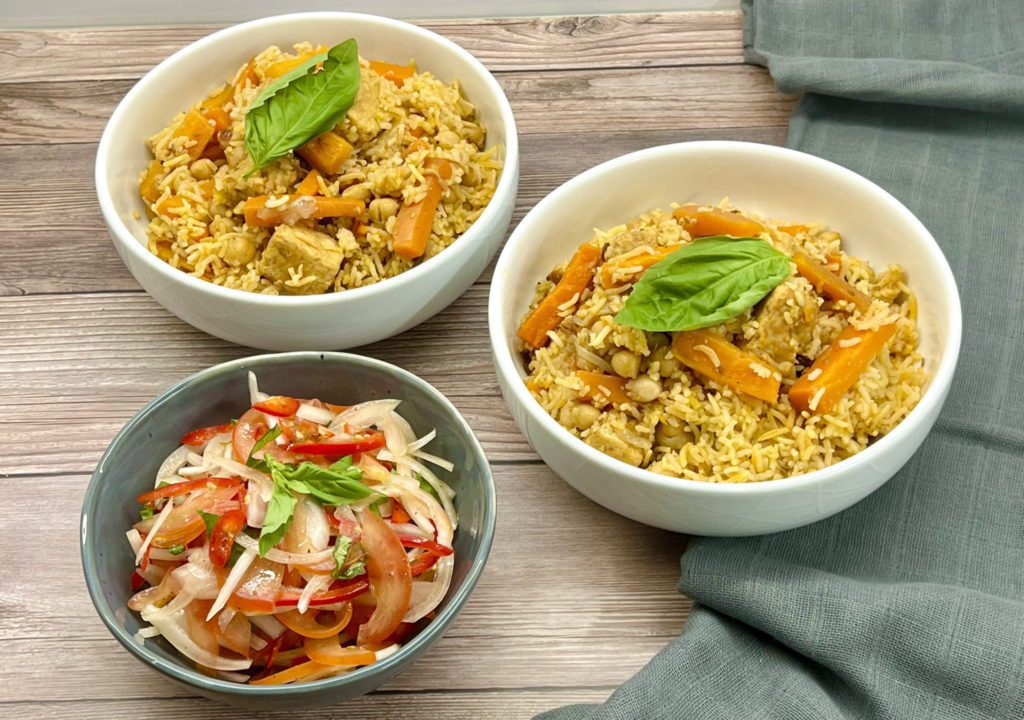
Serving Vegan Plov
Vegan Plov can be eaten at any time of the day, we love it as a warming hearty meal in the dark winter months here in Scotland. Leftovers can be kept in the fridge and reheat well covered in the oven. We love serving Plov with a small side salad to add some fresh flavours and textures. We have a recipe for a quick Uzbek tomato and onion salad.
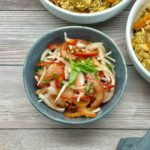
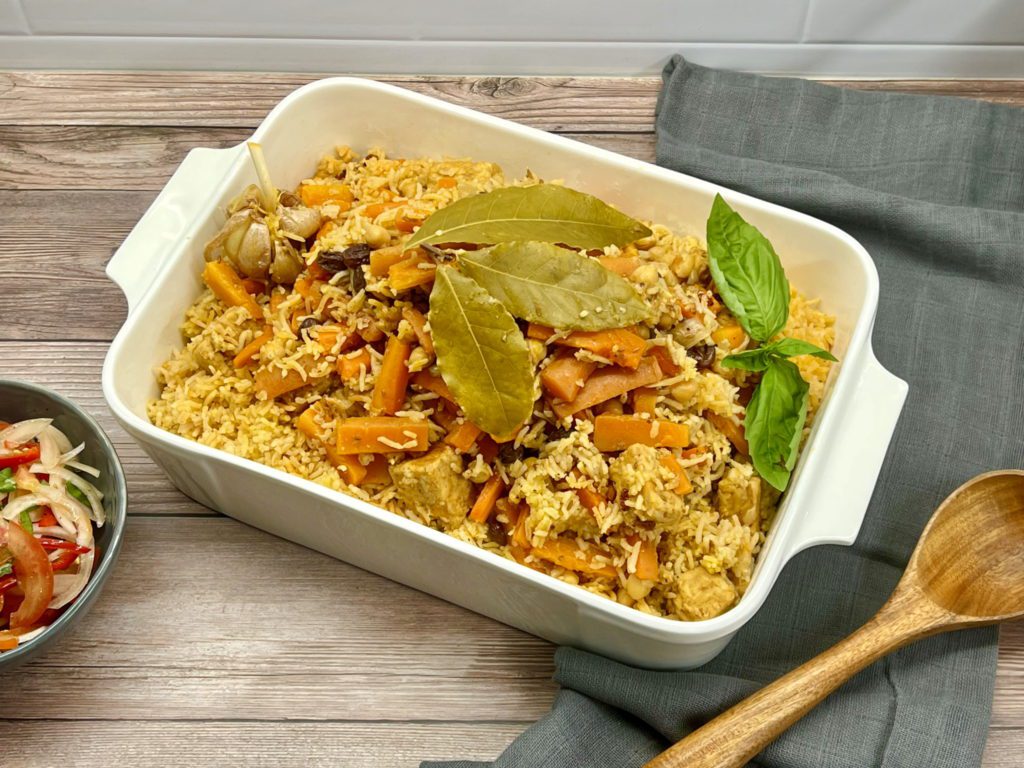
Steps to Cooking the Rice
1. Before adding the rice make sure there is liquid covering the carrot and tempeh mixture.

2. Add the rice on top of the other ingredients in the pan without mixing. Fill with water until the water level is 2cm above the rice.

3. Once the water level has fallen below the level of the rice use a wooden spoon to gently pull the rice away from the edges of the pan and create a small mound. Using the handle of the spoon create holes in the rice down to the liquid below to let the steam rise and fully cook the rice.

4. Lower the heat then cover the pan using a clean dish towel wrapped around the lid. This creates a tight seal and stops any steam from escaping.

Vegan Plov
Equipment
- Large heavy-bottomed pan with a lid such as a cast-iron Dutch Oven.
Ingredients
- 200 g tempeh*
- 1 tablespoon tamari or soy sauce
- 1 tablespoon cumin seeds
- 2 teaspoons coriander seeds
- 4 tablespoons vegetable oil
- 2 onions sliced
- 3 medium carrots cut into batons
- 1 head of garlic
- 1 teaspoon chilli powder
- 1 teaspoon sweet paprika
- 1 teaspoon cracked black pepper
- 2 teaspoons salt
- Hot water
- 3 bay leaves
- 2 tablespoons raisins optional
- 2 tablespoon dry barberries optional
- 400 g tin chickpeas
- 2 ½ cups rice thoroughly washed
- Pinch saffron optional
Instructions
- Cut the tempeh into 2cm cubes. Place the cubes into a flat bottomed dish then pour over the tamari. Let the tempeh soak up the tamari for 10 minutes, turning regularly so every side is coated. Drain excess tamari before cooking.
- Toast the cumin seeds and coriander seeds in a dry pan over high heat until fragrant. Remove the pan from the heat then use a mortar and pestle to roughly grind the seeds. They don’t need to be a fine powder just loosely broken up.
- Wash the rice thoroughly until the water runs clear then submerge in a bowl of cold water to soak. Set aside until later.
- Heat a large heavy-bottomed pan with a lid over medium heat. Use something such as a cast iron dutch oven. Once hot add the oil then add the drained tempeh. Fry on all sides until golden. This will take around 4 minutes.
- Add the sliced onions and fry until soft and starting to turn translucent, around 3 minutes.
- Remove most of the dry outer skin of the head of garlic while keeping it whole. Add the garlic together with the carrot batons to the pan and continue to cook with the onions and tempeh until the onions are fully translucent and soft, around 6 minutes.
- Now add the roughly ground cumin and coriander seeds together with the chilli powder, paprika, black pepper and salt. Stir to coat everything then cook for 1 minute until the spices are fragrant.
- Add enough hot water to fully cover everything in the pan then add the bay leaves, raisins and barberries. Mix everything together then cover the pan and simmer for 10 minutes.
- Taste and adjust the seasoning. It should be slightly too salty at this stage to make sure the rice is seasoned once cooked.
- Once you are happy with the seasoning, stir in the tin of chickpeas then add the rice over the top of everything in the pan. Don’t mix the rice into the other ingredients just layer the rice over. Add more water so that the water level is around 2cm above the rice then cover the pan and let the rice cook for 10 minutes.
- Uncover the pan. The rice should be partially cooked and the water level should be below the level of the rice. Using a wooden spoon gently pull the rice away from the edges of the pan and create a small mound. Using the handle of the spoon create holes in the rice down to the liquid below to let the steam rise and fully cook the rice.
- If using the saffron, grind into a fine powder in a mortar and pestle with a small pinch of salt. Add 3 tablespoons of water then mix until the saffron and salt are dissolved. Now carefully pour over the rice trying to cover as much rice as possible.
- Turn the heat down to the lowest setting on your hob. Cover the pan using a clean dish towel wrapped around the lid. This creates a tight seal. Continue to let the rice steam for 10 minutes then turn off the heat and continue to steam for a further 10 minutes.
- Check if the rice is cooked, if it is mix the rice with the bottom layer then serve. If the rice is not cooked cover again and let steam until cooked.
- Serve with a fresh salad and enjoy. If you would like extra garlic, squeeze one of the cloves out of the cooked garlic head per portion.


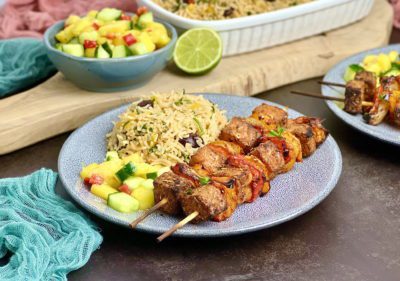
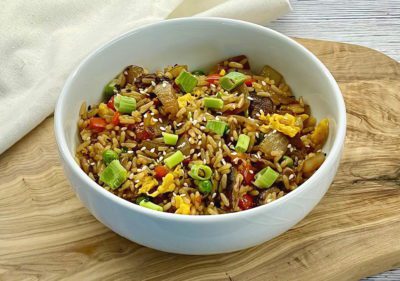
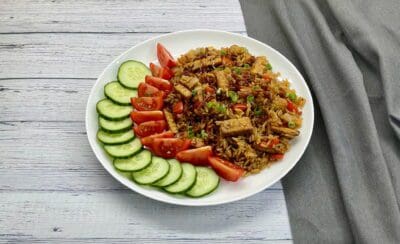

When do you add the chickpeas?
Thanks for pointing this out. I have edited the recipe to include the chickpeas. You add them just before covering with the rice.
Great recipe! Just made it and it’s really very delicious. I added 100g more tempeh and 50g of TVP for more protein. Looking forward to trying your other recipes 🙂
Thank you for the kind words and the review.
Hello, I just found your recipe now and it sounds like exactly what would taste great in the coming days.. a few questions — first up, did you use brown (basmati) rice, or white? If we used the whole/brown version, what changes to the procedure would we need to make? I’m somewhat familiar with biryanis but have never had plov (a good reason to try and make it!)
Also, in reference to the entire head of garlic — do I assume (correctly) that it should be removed once the plov is done? Is it placed in the center for an aesthetic appeal, or it’s just whole ‘because’?
Thanks!!
We used white rice in the recipe. We have never tried this recipe with brown rice so wouldn’t be confident in suggesting changes. However, you will need to add more water and cook it for longer.
For the garlic, cooking it whole is an easy way to cook it while adding a subtle garlic flavour to the dish. As the final step of the recipe suggests, it’s also great for guests to customise how much garlic they like. The recipe suggests adding a single clove per portion. I love garlic and add even more for myself. It becomes this wonderful soft texture that gives such a wonderful flavour.